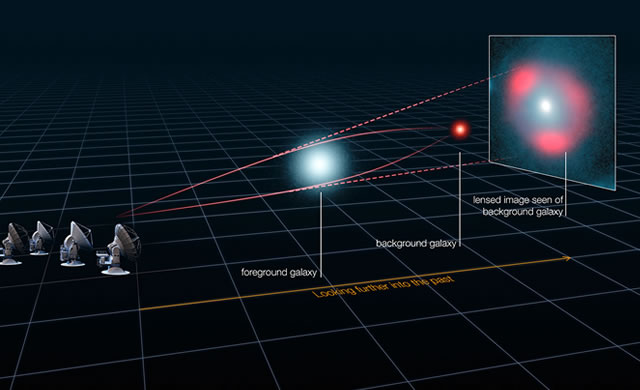
Alcune osservazioni effettuate con ALMA (Atacama Large Millimeter/submillimeter Array) mostrano che il picco della nascita di stelle nel cosmo avvenne molto prima di quanto si pensasse. I risultati sono pubblicati in una serie di articoli sulle riviste Nature e Astrophysical Journal il 14 marzo 2013. Questa ricerca rappresenta l’esempio più recente delle scoperte provenienti dall’osservatorio internazionale ALMA, che oggi viene inaugurato.
Si pensa che il picco più alto della produzione di stelle si sia verificato nell’Universo primordiale in galassie brillanti e massicce. Queste galassie, chiamate “starburst”, convertono vaste riserve di gas e polvere cosmici in nuove stelle a un ritmo furibondo – molte centinaia di volte più in fretta che in una galassia a spirale solenne come la nostra, la Via Lattea.
Osservando lontano nello spazio, fino a galassie così lontane che la loro luce ha impiegato molti miliardi di anni per giungere fino a noi, gli astronomi possono osservare questo periodo così movimentato della gioventù dell’Universo. “Più è lontana la galassia e più indietro nel tempo si guarda, così misurando la distanza delle galassie possiamo costruire una cronologia di quanto vigorsamente l’Universo stava creando stelle nelle diverse tappe della sua storia da 13,7 miliardi di anni”, ha detto Joaquin Vieira (California Institute of Technology, USA), a capo dell’equipe e primo autore dell’articolo sulla rivista Nature. L’equipe internazionale di ricercatori ha scoperto queste galassie “starburst” lontane ed enigmatiche con il telescopio SPT (South Pole Telescope: Telescopio al Polo Sud) da 10 metri della NSF (National Science Foundation) degli USA e poi ha usato ALMA per focalizzarsi ad esplorare il “baby boom” delle stelle nell’Universo giovane. Sono stati sorpresi di scoprire che molte di queste galassie distanti, piene di polvere e che formano stelle erano ancora più lontano del previsto. Ciò significa che, in media, il picco della formazione stellare avvenne 12 miliardi di anni fa, quando l’Universo aveva poco meno di 2 miliardi di anni – almeno un miliardo di anni prima di quanto si pensasse. Due di queste galassie sono le più lontane mai viste del loro genere – così distanti che la loro luce iniziò il suo cammino quando l’Universo aveva solo un miliardo d’anni. E inoltre, in una di queste galassie da record, l’acqua si trova tra le molecole rilevate, rendendola l’osservazione di acqua più lontana nel cosmo mai pubblicata.
Fonte/Leggi tutto → ESO.org
Observations with the Atacama Large Millimeter/submillimeter Array (ALMA) show that the most vigorous bursts of star birth in the cosmos took place much earlier than previously thought. The results are published in a set of papers to appear in the journal Nature on 14 March 2013, and in the Astrophysical Journal. The research is the most recent example of the discoveries coming from the new international ALMA observatory, which celebrates its inauguration today.
The most intense bursts of star birth are thought to have occurred in the early Universe, in massive, bright galaxies. These starburst galaxies convert vast reservoirs of cosmic gas and dust into new stars at a furious pace — many hundreds of times faster than in stately spiral galaxies like our own galaxy, the Milky Way.
By looking far into space, at galaxies so distant that their light has taken many billions of years to reach us, astronomers can observe this busy period in the Universe’s youth. “The more distant the galaxy, the further back in time one is looking, so by measuring their distances we can piece together a timeline of how vigorously the Universe was making new stars at different stages of its 13.7 billion year history,” said Joaquin Vieira (California Institute of Technology, USA), who led the team and is lead author of the paper in the journal Nature. The international team of researchers first discovered these distant and enigmatic starburst galaxies with the US National Science Foundation’s 10-metre South Pole Telescope (SPT) and then used ALMA to zoom in on them to explore the stellar baby boom in the young Universe. They were surprised to find that many of these distant dusty star-forming galaxies are even further away than expected. This means that, on average, their bursts of star birth took place 12 billion years ago, when the Universe was just under 2 billion years old — a full billion years earlier than previously thought. Two of these galaxies are the most distant of their kind ever seen — so distant that their light began its journey when the Universe was only one billion years old. What’s more, in one of these record-breakers, water is among the molecules detected, marking the most distant observations of water in the cosmos published to date.
Source/Continue reading → ESO.org
Leggi anche/Read also: ESO – 13 Marzo 2013: Live Streaming dell’inaugurazione di ALMA – 13 March 2013: Live Streaming of ALMA Inauguration





















